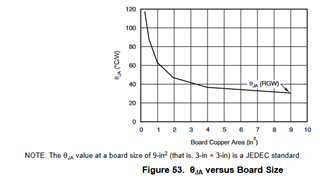Other Parts Discussed in Thread: , TPS7A57
Hi,
A question: the TPS7A94 datasheet does not provide a specific amount of copper needed for thermals so the device runs cool enough to hit the current spec.
The TPS7A94EVM-046 board has quite a bit of copper on it. Seems like all four layers are part of the thermal reduction strategy.
The EVM board measures 2.85 x 3.35 inches, so this is 9.55 in^2.
Is there a guideline for the amount of copper needed for a smaller board? Would an amount of half the EVM be sufficient or is it another scaler factor?
dennis brown





